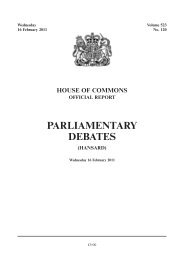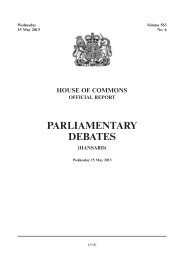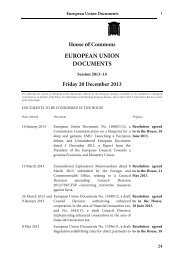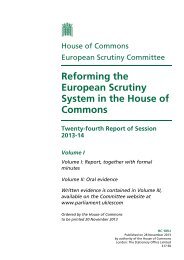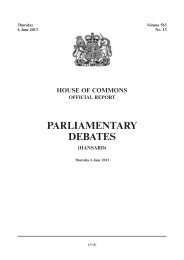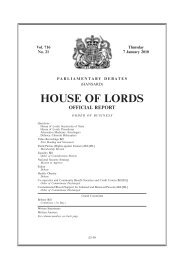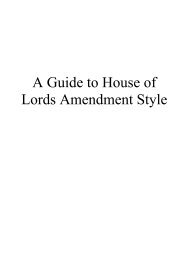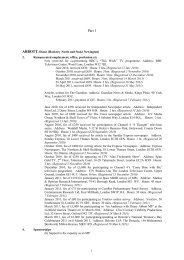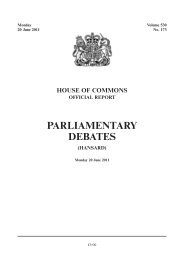View PDF - United Kingdom Parliament
View PDF - United Kingdom Parliament
View PDF - United Kingdom Parliament
Create successful ePaper yourself
Turn your PDF publications into a flip-book with our unique Google optimized e-Paper software.
69 Marine and Coastal Access Bill 26 OCTOBER 2009 Marine and Coastal Access Bill 70<br />
[Lords]<br />
[Lords]<br />
have recourse to the objections procedure set out in<br />
schedule 19, should Natural England not undertake a<br />
review or amend its report accordingly.<br />
6.15 pm<br />
I understand the concerns of the House that the<br />
coastal access provisions should not prevent future<br />
changes in land use. For this reason, I have been talking<br />
to stakeholders, explaining how the provisions will work<br />
and providing reassurance that the Bill will be implemented<br />
in a way that does not sterilise land by preventing any<br />
future changes. I understand the hon. Gentleman’s concern,<br />
but I want to make it clear that we are not in the<br />
business of allowing a coastal path to mean no future<br />
development, which would go against the whole ethos<br />
of the Bill.<br />
Bill Wiggin: Will the Minister elaborate a little more<br />
on what he means by “sterilise”? Does he mean, for<br />
example, that the land would not be eligible for single<br />
farm payments?<br />
Huw Irranca-Davies: The hon. Gentleman tempts me<br />
down a path on single farm payments that I am wary of<br />
treading on. It is more to do with how proposals for<br />
future land use are developed. In my own constituency,<br />
for example, an area has been designated for light<br />
industrial use for 20 years, yet there is no light industrial<br />
use on it. If we were to incorporate that sort of approach<br />
into the coastal margin, we could well end up with a<br />
coastal path or coastal margin without any integrity or<br />
coherence—a coastal path with big red lines all the way<br />
along it. There might be further proposals for every<br />
couple of miles along the path. We need to ask how one<br />
defines a proposal. Is something defined as a proposal<br />
because it features in a local development plan or a<br />
unitary development plan some years down the line? Is<br />
it a proposal if some supermarket or retailer has said<br />
that it might be interested somewhere down the line? I<br />
shall explain in more detail later why that simply would<br />
not work.<br />
I understand the concerns, which is why I used the<br />
term sterilised land, about the idea that if a coastal path<br />
were put in place, it would mean that no development<br />
could happen. We do not want that. On the contrary, I<br />
believe that the Bill’s provisions are extremely flexible in<br />
that respect. Let me explain why I believe the necessary<br />
safeguards are in place.<br />
At the outset, before drawing up a report on a particular<br />
stretch of coast, Natural England will take appropriate<br />
account of any relevant local plans, such as local<br />
development plans and planned major developments,<br />
as part of its consultation with landowners, local authorities<br />
and others, including the Marine Management<br />
Organisation. As we are all aware, the MMO will be<br />
consulted on any plans that could affect the marine<br />
environment as a result of the Bill. It is likely to have a<br />
pretty good knowledge of what is coming down the<br />
track, including some of the much further afield national<br />
infrastructure developments. I encourage all those affected<br />
to engage in constructive discussions with Natural England<br />
at this early stage on the best position for the route.<br />
As part of the local consultations on the route and<br />
spreading room, Natural England will discuss the need<br />
for any exclusions or restrictions on access. Any necessary<br />
exclusions or restrictions will be included in Natural<br />
England’s report and put in place before the right of<br />
access to that particular stretch of coast comes into<br />
effect. If circumstances change at a later date, those<br />
with an interest in the land can apply for restrictions or<br />
exclusions under sections 24 and 25 of the CROW Act<br />
—for example, for land management purposes. The<br />
flexibility is built in there.<br />
Once the route is implemented, under the provisions<br />
in the CROW Act, land can become excepted from the<br />
right of access at any time if some change or development<br />
occurs so that it falls into one of the excepted land<br />
categories in schedule 1 to the CROW Act. These<br />
include, for example, land covered by buildings or the<br />
curtilage of such land; land used for the purposes of<br />
railways or tramways; and land that does not fall within<br />
some other excepted land categories and is covered by<br />
works used for the purposes of a statutory undertaking.<br />
Paragraph 9 of that schedule makes specific provision<br />
for development in establishing a category of excepted<br />
land as follows:<br />
“Land as respects which development which will result in the<br />
land becoming land falling within any of paragraphs 2 to 8 is in<br />
the course of being carried out.”<br />
Paragraphs 2 to 8 include the categories that I have<br />
already mentioned. I apologise for being so detailed on<br />
the matter, but it is important.<br />
In addition, it is worth reminding hon. Members that<br />
the line of the route is not fixed permanently. Powers in<br />
section 55 of the National Parks and Access to the<br />
Countryside Act 1949 enable Natural England to review<br />
the route and associated margin and to propose changes<br />
to the Secretary of State at a later date—subject, once<br />
again, to full consultation, representation and the objections<br />
process. In those ways, the legislation is designed to take<br />
account of changes in use and future developments.<br />
I consider it neither appropriate nor practical that a<br />
person with a relevant interest in land should be able to<br />
require Natural England to carry out a review of a<br />
report on the basis of a proposed development, or to<br />
have recourse to the objections procedure in schedule 19<br />
to the Bill, if Natural England does not agree to amend<br />
the report on the basis of such a proposal. At the proposal<br />
stage, it may be several years before a determination on<br />
any eventual planning application is reached—we are<br />
all familiar with that in our constituencies—or the<br />
change of use is implemented or development begun,<br />
and the final agreed development may be significantly<br />
different from the original proposal in size and shape.<br />
Such an approach, which could preclude access for<br />
some time, would not be considered fair to the local<br />
community or other users, and would not help us to<br />
deliver on our aspirations for a coastal path.<br />
As I have explained, if a change of use or development<br />
occurs so that land falls within one of the categories of<br />
excepted land in schedule 1 to the CROW Act, it<br />
becomes excepted from the right of access. If land over<br />
which the coastal route passes becomes excepted land, I<br />
would expect Natural England to review its report and<br />
propose a revised route so that continuity is maintained.<br />
Indeed, it would be difficult to see how Natural England<br />
would be fulfilling its coastal access duty were continuity<br />
of the path not maintained.<br />
I recognise the concerns of landowners and occupiers<br />
about any possible impacts of the right of access on<br />
future change of land use or development. Planning



